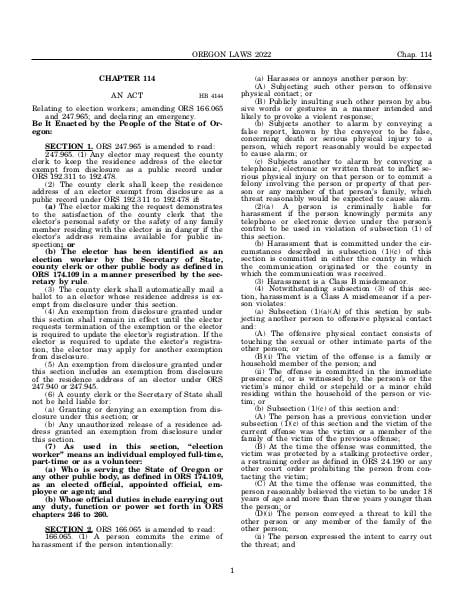Harassment

Amended by HB 4144
Effective since April 4, 2022
Relating to election workers; amending ORS 166.065 and 247.965; and declaring an emergency.
Mentioned in
The Oregon Harassment Laws & Penalties Guide
“Harassment in Oregon includes behaviors such as verbal abuse, inappropriate jokes, posting comments about you on social media, bullying, or even making faces at you.”
Bibliographic info
Source:
Section 166.065 — Harassment, https://www.oregonlegislature.gov/bills_laws/ors/ors166.html.
Notes of Decisions
“Course of conduct” is a pattern of conduct composed of same or similar acts repeated over a period of time, however short, which establishes a continuity of purpose in the mind of the actor. State v. Sallinger, 11 Or App 592, 504 P2d 1283 (1972)
“Offensive physical contact” includes striking, slapping, shoving, kicking, grabbing and similar acts that are an interference with the contactee, regardless of whether they produce any pain or discomfort. State v. Sallinger, 11 Or App 592, 504 P2d 1283 (1972)
Requirement that person act with specific intent to “harass, annoy or alarm” is not unconstitutionally vague. State v. Sallinger, 11 Or App 592, 504 P2d 1283 (1972)
Requirement that person subject another person to “offensive physical contact” is not unconstitutionally vague. State v. Sallinger, 11 Or App 592, 504 P2d 1283 (1972)
Prohibition against conduct constituting harassment by “telephone, mail or other form of written communication” is not unconstitutionally vague. State v. Zeit, 22 Or App 480, 539 P2d 1130 (1975)
Prohibition against conduct that “alarms or seriously annoys” another person is unconstitutionally vague. State v. Sanderson, 33 Or App 173, 575 P2d 1025 (1978)
Notwithstanding that initial stop of defendant was unlawful under ORS 131.615, such illegality did not render inadmissible defendant’s subsequent behavior, for which he was charged under this section. State v. Gaffney, 36 Or App 105, 583 P2d 582 (1978), Sup Ct review denied
Spitting on another can be offensive physical contact within meaning of this section. State v. Keller, 40 Or App 143, 594 P2d 1250 (1979)
Prohibition against communications that are “likely to cause annoyance or alarm” is unconstitutionally vague. State v. Blair, 287 Or 519, 601 P2d 766 (1979)
Publicly insulting another by abusive or obscene words or gestures in manner likely to provoke violent or disorderly response with intent to harass, annoy or alarm, violates section 8, Article I, Oregon Constitution, because it is directed to speech and is not “wholly confined within some historical exception” to that constitutional section. State v. Harrington, 67 Or App 608, 680 P2d 666 (1984), Sup Ct review denied
Proscription against “offensive physical contact” is directed toward conduct not speech and does not violate section 8, Article I, Oregon Constitution. State v. Beebe, 67 Or App 738, 680 P2d 11 (1984), Sup Ct review denied
Harassment by causing telephone to ring with no communicative purpose, is clear and unambiguous. State v. Lowery, 71 Or App 833, 693 P2d 1343 (1984)
Prohibition against telephonic or written threats, where focus is on effect not speech and effect must be objectively as well as subjectively genuine, is neither constitutionally overbroad nor vague. State v. Moyle, 299 Or 691, 705 P2d 740 (1985)
Telephonic or written threat must be genuine and pose objective risk of breach of peace and failure by defendant to act on threat may suggest it was not genuine, but failure does not compel such conclusion. State v. Mapula, 80 Or App 146, 720 P2d 1336 (1986), Sup Ct review denied
Harassment did not occur by phoning of bomb threat when recipient of threat was not actually placed in fear. State v. Wilson, 81 Or App 48, 724 P2d 840 (1986), Sup Ct review denied
Where harassment is not lesser included offense under charge of assault in fourth degree, defendant’s conviction for harassment is reversed. State v. Warren, 101 Or App 446, 790 P2d 47 (1990)
Harassment by touching sexual or intimate parts of another is not lesser included offense of sexual abuse in first degree (ORS 163.427). State v. Barnes, 209 Or App 332, 147 P3d 936 (2006), Sup Ct review denied
Prohibition of this section is facially overbroad so as to violate constitutional right of free speech. State v. Johnson, 345 Or 190, 191 P3d 665 (2008)